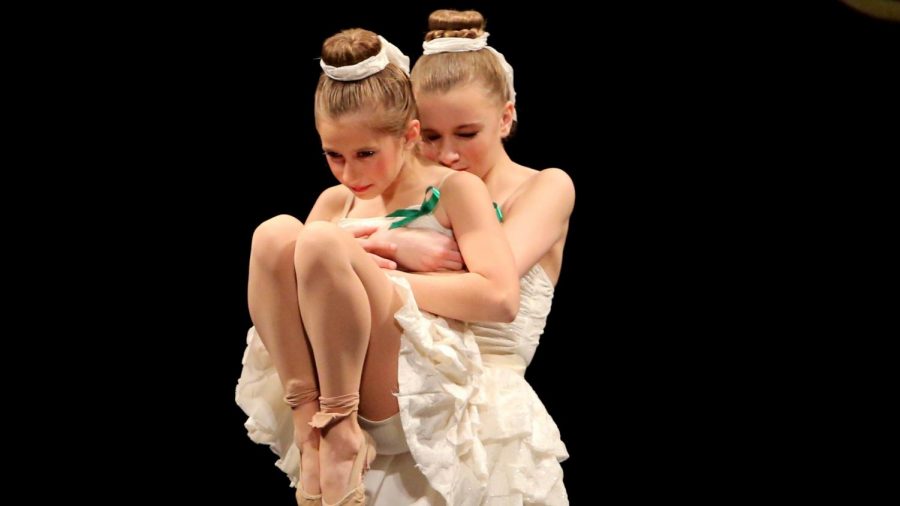Dance Moms: Reality television is hardly realistic
courtesy of On Point Dance Competition
Authors Ashley Nash and Kelsey Ward dance at a competition.
January 24, 2018
The Lifetime series Dance Moms is a show filled with drama, fighting, and of course — dancing. The show first aired in 2011 and professes to reveal the real the behind the scenes of the Abby Lee Dance Company from Pittsburgh.
There are seven dancers on the team. The show’s success comes from the conflicts among the dancers, the moms and Studio Owner, Abby Lee Miller. Miller is constantly ranking the dancers based on their dancing, attitude, effort and the attitudes of their mothers.
After watching this show, you would think that all dance teams are filled with complaining, petty and backstabbing girls (and boys), but this is not the case.
This show continues the many ongoing stereotypes against dancers. There are two main stereotypes, villainess and victim. It is stereotypes like these that are degrading women.
In our experience, Most dance teams are so close that they consider themselves to be a second family. Everyone supports each other. They are there to be happy when someone wins and be sad together if someone struggles.
Junior, Haley Stone, a dancer at Savage Dance Company, said, “I have experienced other studios at competitions who have acted like the Dance Moms do. In my personal experience, my dance studio is like a family. We are all about our family and supporting one another.”
We have both been competitive dancers for six years at Cheryl O’Hara Dance Elite in Ijamsville. O’Hara ranks by age groups and experience, but there is no pyramid and primadonnas.
Even though dance competitions are supposed to be competitive, they really aren’t as cutthroat as you may think. Here are some common misconceptions of the dance world.
What people think: Many people think that like other sports, there is only one winner.
Reality: There are multiple winners because there are many categories.
A typical dance competition starts on Friday afternoon and ends Sunday night. There are three days full of dancing, starting at 8:00 a.m. and ending at around 10:00 p.m. Most competitions have about 300-500 routines, each of which is about 3-4 minutes long.
There are two broad categories based on skill level, “recreational” and “competitive.” Within these two categories, dances are classified by the age range, the number of dancers, and the style of dance.
Each dance gets an adjudication award, which ranks the dance based on their score. Each competition has its own categories and names for these awards. On Point Dance Competition gives out gold, high gold and platinum awards. Starpower Talent Competition gives out anywhere from 3 to 5 stars.
There are other awards that dance teams can receive, such as special judges awards, best technique, most entertaining, and best choreography.
What people think: All dance teams are rivals.
Reality: Yes, the teams are competing against each other, but the atmosphere in the auditorium is happy and supportive. Everyone cheers and claps for other dances, wishes each other good luck, and when someone does an insanely good trick, the whole audience goes crazy.
What people think: All that moms of dancers do is fight and criticize each other.
Reality: There can be tensions on the team and with the moms because each mom wants her son or daughter to be a star. At the end of the day, though, every mom would do anything to help a team member. Our moms have made costumes for other girls on the team, helped with hair and makeup, and driven girls to competitions.
What people think: Dance isn’t a sport, and dancers aren’t athletes.
Reality: Dancers put countless hours into working on core, strength and flexibility. They work as a team doing tedious work to make a routine look absolutely perfect. We would practice with our team about 10 to 15 hours a week.
“Reality TV gives people the wrong image of dancers. They are shown as ditzy drama queens and not as the true athletes they are. They long hours of training and hard work are never taken into account,” said Stone.
The dancers portrayed on TV are overdramatized. By buying into the crazy catfighting that we see on these reality shows, we are degrading all women. We are letting the media shape the image of women and of dancers.
We are trying to break these stereotypes and show people that dance is a sport full of hardworking athletes.



